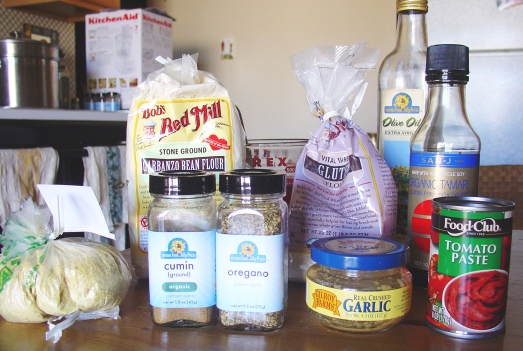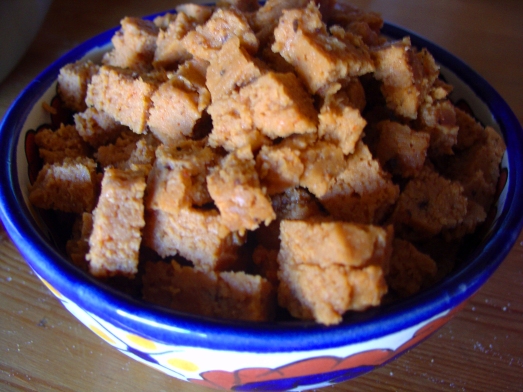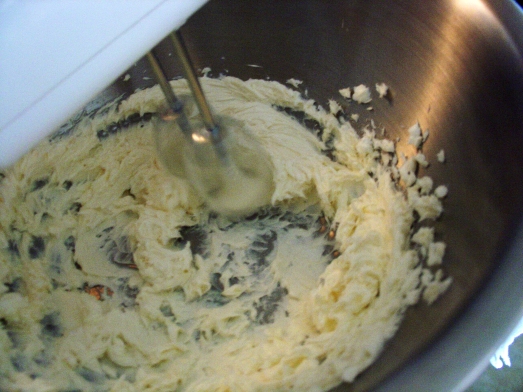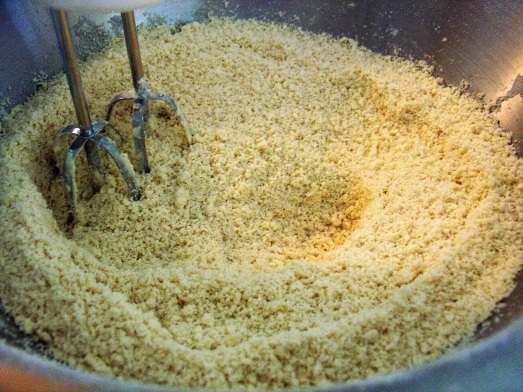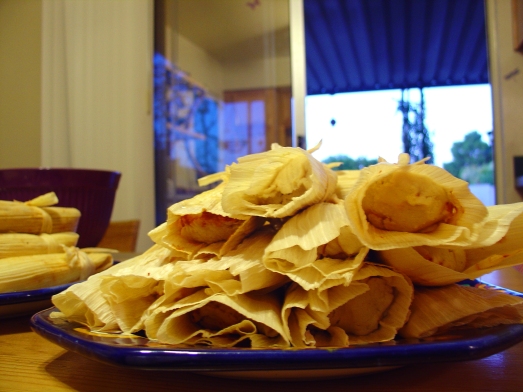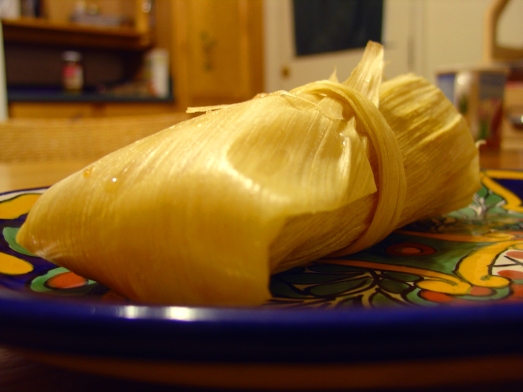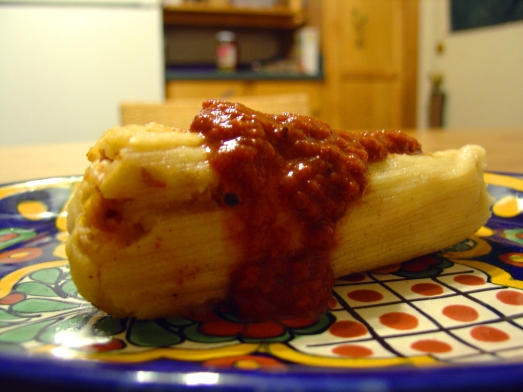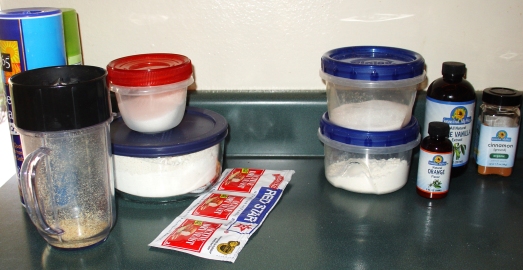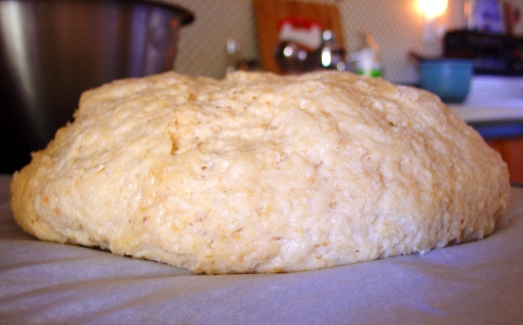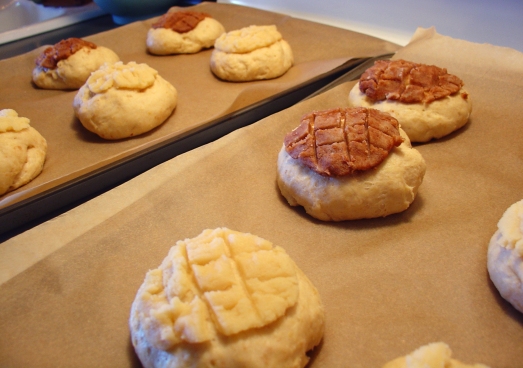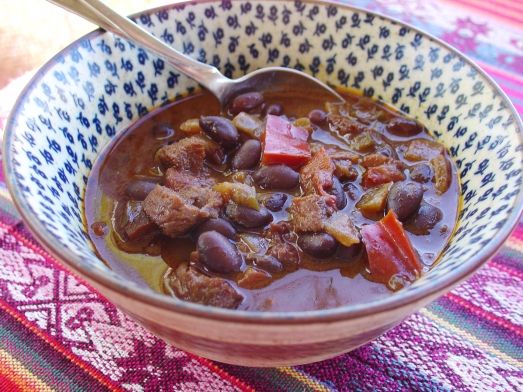Let me start with this statement: I love tamales.
(Hopefully that will serve to explain the existence of this long, rambling post.)
As with mole and pan dulce, the first time I can remember having eaten a tamale is August of 2006, in Mérida, Mexico. In the state of Yucatán, (where the city of Mérida is located) tamales are slightly different than those you find at most Mexican restaurants in the US. In Yucatán, traditional restaurants and cocina económicas (small restaurants or individuals who cook a different type of food each day of the week) sell a special variety of tamales, called vaporcitos. Vaporcitos are cooked in banana leaves instead of corn husks, which give them a slightly different flavor. Throughout my time in Mexico, Saturday was tamale day. My host mom would go to a nearby cocina económica and bring me home two delicious tamales. They were so flavorful and moist that I didn’t even add sauce to them, except for a little bit of super-spicy salsa de chile habanero. (I should add that, during my semester in Mexico, I temporarily took a break from eating vegetarian, which I was at the time, so that my host family wouldn’t need to make me my own special meat-free food.)
Since then, I’ve tried vegetarian tamales at Mexican restaurants. I never liked them much because they were drowned in sauces and cheese. I did quite enjoy Trader Joe’s Cheese and Green Chile tamales, before I decided to start eating vegan. However, these very cheesy tamales tasted nothing like the tamales I remembered from Mérida, which had been filled mostly of some sort of meat and sauce.
So, when I saw recipes for vegan tamales in Terry Hope Romero’s Viva Vegan, I was excited. Not just a little bit excited, but very excited. Very, very excited.
It took me a while to work up the cooking-confidence to give it a try, but that time finally came.
Of the several varieties she has recipes for, I chose to make the Red Chile-Seitan Tamales. These tamales, she said in the book, would fairly closely resemble traditional red chile tamales. Cooking the tamales actually required four different recipes, all from Viva Vegan. First I made the Steamed Red Seitan (to act as the meaty filling). Then I made the Red Chile Sauce. Next, I prepared the Savory Vegan Masa Dough. Last, I was ready to follow the directions for the tamales themselves. It was a multi-day, many-hour process. But in the end, I can unequivocally say that it was worth it. These tamales may be the most delicious things I have ever eaten.
This post is going to be image-heavy, because tamales are beautiful. Unfortunately (or perhaps fortunately, I’m not sure), I dropped my camera and ended up loosing some pictures. (And, by dropped I actually mean: walked into the cord attaching it to the wall while the battery was charging and ended up flinging the camera across the room and onto the floor). The camera still works (it is a hearty little camera – approaching its eight birthday), it’s just that some of the files became corrupted during the camera’s failed attempt at flight.
Okay, onto the tamales.
First, I made the Steamed Red Seitan. While I had previously made seitan sausages, I had never just steamed a loaf of seitan to use in cooking. I had bought the water-packed kind at the store a few times. It was expensive. I was ready to make my own.
The ingredients are fairly basic (if you already happen to have vital wheat gluten and garbanzo flour, as I did).
After you mix it all together, knead it, wrap it in tinfoil, steam it, cool it, and cube it, it looks like any store-bought seitan!
Next, I made the Red Chile Sauce.
After removing the stems and deseeding the chiles, they were ready to be cooked together with onions, tomatoes, vegetable broth, and spices.
The next step was to puree the sauce. Unfortunately, I did not heed the directions on my food processor, and filled the bowl much higher than the fill line. There was sauce pouring out of every part of the food processor. It was a pretty impressive mess, and I now know to not put liquids above the fill line on my food processor.
A few days later, I got ready to mix the masa and assemble the dough. I was a little overwhelmed and basically just threw everything onto the table in a big mess of ingredients.
I have the broth, the vegetable shortening, the Earth Balance, the baking powder, the garlic powder, the salt, and the masa for the dough. I have the sauce already made in the tupperware containers, and the seiten already made and cubed. I have the onion and red peppers sliced and ready to saute for the filling. I also have way too many corn husks. (I wanted to be prepared!) And, the most important part – the Viva Vegan cookbook!
First, I started by creaming together the Earth Balance and the shortening. Even though I use non-hydrogenated organic shortening, it still sort of grosses me out. It’s just so greasy (which makes sense, since it’s oil…)
Then I added the dry ingredients to the creamed fat.
After the dough reached a “sandy” consistency, I added the vegetable broth and mixed until smooth.
At this point, I had all the components ready. All I had to do was assemble. The assembly process was surprisingly easy, though it did take quite a while. But it was enjoyable mindless work, and pleasant enough. By the time I ran out of masa, I had 21 gorgeous tamales, wrapped in corn husks and tied shut with little strips of cornhusk.
After I finished wrapping the first tamale, I was flabbergasted that it actually looked like a tamale! Like, the kind you’d buy from somewhere. And I had just made it. From scratch! A real, live, (well, not live since no animals were harmed in the making of these tamales) tamale!
I started snapping photographs left and right. These tamales have been more photographed than most celebrities.
Then, I lined the steamer basket with extra corn husks, and piled the tamales in.
My 21 tamales just fit in the steamer. I think it’s a good thing that I didn’t make 24 like the recipe stated I should – I don’t know that they all would have fit!
The next thing I knew, 65 minutes were up, and the tamales were ready to be removed from the heat. Then, after another excruciating 15 minutes, they were ready to be eaten.
I took one out of the steamer basket and laid it on a plate.
It still, surprisingly enough, looked like a tamale.
This tamale had a jaunty side-tied knot.
It’s like playing peek-a-boo with the tamale. Or else, perhaps the tamale is going to jump out and attack. I can hear the Jaws theme now… (Only, no shark would eat this tamale, because it’s meat-free!)
After all the dramatics of admiring the husk, I was ready to open it up and find out for certain if it had turned into a tamale.
So, I cautiously opened it, and found inside, a perfectly formed tamale! I poured on some more red chile sauce.
Amazing.
Fabulous.
So, at this point I knew that it looked like a tamale, and smelled like a tamale, but the biggest question was, did it taste like a tamale.
I will let this g-chat conversation, between me and my sister and occurring moments after I tasted my first tamale, answer that question:
.
As you can see, I loved these tamales so much that apparently I forgot how to appropriately use capital letters. (And I’m a teacher. Teachers are always supposed to follow capital letter rules.) While I was on a tamale high, my sister was substantially less impressed. Of course, that’s only because she didn’t have any gloriously amazingly scrumptious vegan tamales to eat.
Overall, the tamales were quite a process. They took a long time. A long, long time. They created a mess. Quite a mess. But they are delicious. So, so, delicious. They are sweet and meaty and saucy and masa-y and everything else that tamales should be.
I think the next tamales I make will be Chocolate Brownie Tamales. I found the recipe on Terry’s (the author of Viva Vegan) website and they look great. Chocolate and tamale? They aren’t exactly traditional, and I never would have thought the two could be combined…but now that I know they can, I need to make them. And I do have two extra bags of corn husks, along with most of a package of masa. Look for pictures of these chocolate tamales within the next few weeks… I don’t think it will be long before these are made.

